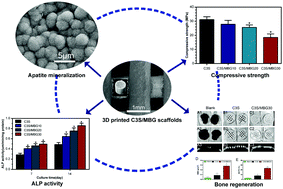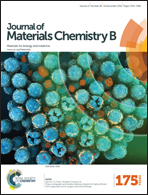Three-dimensional printing of tricalcium silicate/mesoporous bioactive glass cement scaffolds for bone regeneration
Abstract
Bone defects, particularly large bone defects resulting from infections, trauma, surgical resection or genetic malformations, remain a significant challenge for clinicians. In this study, the tricalcium silicate/mesoporous bioactive glass (C3S/MBG) cement scaffolds were successfully fabricated for the first time by 3D printing with a curing process, which combined the hydraulicity of C3S with the excellent biological property of MBG together. The C3S/MBG scaffolds exhibited 3D interconnected macropores (∼400 μm), high porosity (∼70%), enhanced mechanical strength (>12 MPa) and excellent apatite mineralization ability. Human bone marrow-derived mesenchymal stem cells (hBMSCs) were cultured on the scaffolds to evaluate their cell responses, and the results showed that C3S/MBG scaffolds could stimulate the attachment, proliferation and differentiation of hBMSCs with increasing MBG component. The critical-sized rat calvarial defect animal model was employed; further in vivo results indicated that both C3S and C3S/MBG30 scaffolds could induce new bone formation, but the C3S/MBG30 scaffolds significantly improved the osteogenic capacity compared to the pure C3S scaffolds. Therefore, the C3S/MBG cement scaffolds fabricated by 3D printing with a curing process would be a promising candidate for bone regeneration.


 Please wait while we load your content...
Please wait while we load your content...